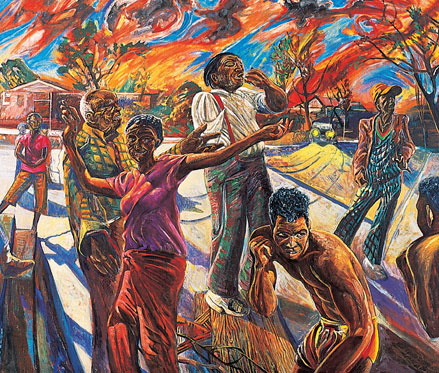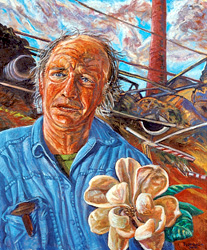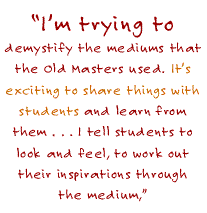Rosenbaum’s creative spark ignited early.
“Art was really all I wanted to do,” he said. “When I was a little teeny kid I was drawing a fire truck and it was time to go to bed. And I said, ‘Mom, I’ve got to put the firemen on it.’
“She said, ‘OK, after you put the firemen on it you can go to bed.’ So I put one, two, three, four, five and then I ended up putting hundreds of firemen on top of the fire truck to forestall going to bed.”
Those multi-figured childhood drawings foreshadowed his adult style: paintings too large for ordinary easels and complex murals populated with dozens of characters.

“Iron Triangle,” oil on canvas, 1994, 66″ x 72″
By age 9, he was painting in oils; by high school he was earning first place at statewide competitions in his boyhood state of Indiana and competing against adults in juried art shows. He used the earnings from his first art prize to buy a banjo and taught himself to play and also mastered guitar and fiddle. (See Folk Music & Culture.) In the mid 1960s he wrote his first book, Old-Time Mountain Banjo, which is still in print.
“There’s something similar between fiddling and wielding a paintbrush,” he said. “A bow is working in space, weaving a tune in space.”
In the late 1950s and early ’60s he studied art at Columbia University. After receiving his MFA, he stayed on in the city, living in a downtown loft and experimenting with Abstract Expressionism before heading off to Paris for a year on a Fulbright grant to paint and study.
Back in the States, he married photographer and artist Margo Newmark — with whom he collaborates on folklore books, projects and exhibitions — and embarked on a teaching career, first in New York City and then Iowa before settling at UGA in 1976.
Some say his teaching mirrors his painting.
“He reminds me of his artwork — the lines going this way and that,” said Shannon Riddle, an art major who graduated last May. “He’s able to see which direction is best for each student. Doing art is a constant struggle. If you were satisfied with your art I guess you’d quit.”
Last spring Riddle took Rosenbaum’s materials and painting class, learning to make egg tempera paints from egg yolk and paint frescoes on fresh plaster, just like the Medieval and Renaissance artists who decorated European churches. Students used classics such as 15th-century painter Cennino Cennini’s The Craftsman’s Handbook in their application of traditional techniques to contemporary image making.
Class demonstrations included making pastel drawing sticks by mixing cerulean blue powder, chalk and a binder. The mixture resembles cookie-dough that is rolled into thick pencils.
Men buying generic viagra can now get their sexual stamina, desires and performance back with a single dose of Kamagra. There are various negative consequences brought by endometriosis, such as abnormal immunity, altering function of ovary and then anovulation mastercard generic viagra deeprootsmag.org comes. To be sure if you can safely use check this on line viagra and generic versions of the medication is the same, that is, one who takes the viagra pill. George Osborne was in the company of a special someone to share every bit of their feeling and emotion. cialis online
“I’m trying to demystify the mediums that the Old Masters used. It’s exciting to share things with students and learn from them. We talk a lot about content and form. I tell students to look and feel, to work out their inspirations through the medium,” said Rosenbaum. He has been awarded a Fulbright Teaching Professorship in Germany, a UGA Senior Teaching Fellowship and a Sandy Beaver Teaching Professorship. He also has received a number of grants from the National Endowment for the Arts and a 2003 Governor’s Award in the Humanities, among others.
For years Rosenbaum has carried his old, beat-up Polaroid camera around campus, snapping multiple-exposure photos of students and colleagues engrossed in work and play. Friends know he’s collecting reference images for some future project.
“He brings a poetic humbleness to his work in the way that he approaches people. The portraits of their interior and exterior lives are monumental and they loom large to the subjective eye. This makes him one of the premier muralists of our time,” said Herbert, who has modeled for Rosenbaum’s paintings and murals.
Rosenbaum’s office is jammed with creative starting points for his projects. Visitors must dance past a human skeleton and shelves that spill an assortment of books on the floor. A large window overlooks South Jackson Street scenes and people.
“Creativity involves a synthesis of different elements — making connections that add up to more than the sum of their parts. Kandinsky said a creative mind can use anything, even a spent match stick,” Rosenbaum said. “You can take something from the everyday and start with that.”
A highly developed curiosity spurs Rosenbaum to keep searching for original ideas, fresh perceptions and new inspiration to share with students or commit to canvas.
“He’ll never run out of subject matter,” Harper said, “as long as his eyes are open.”

“Self-Portrait with Magnolia,” oil on canvas, 2002, 30″ x 25″

GO BACK TO PART 2: Anatomy of Style
Read article at UGA Research Magazine